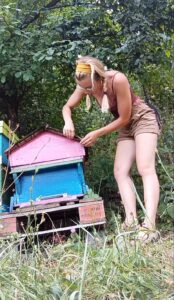Bees – A Glimpse into the World of Bees: Honey Production and Life in the Hive
On our land in Trinoga, we have the pleasure of managing six beehives – a fascinating journey into the world of bees that provides us not only with valuable honey but also with deeper insights into the lives of these amazing insects.
Our beehives are more than just a source of sweet honey. Each hive is a complex, living system with a clear hierarchy and division of labor. While five of the hives are currently supported by a sugar water mixture, what we call “fake honey,” and a bit of thyme powder for parasite control, we are preparing to use the sixth hive for honey production.
The fascinating world of bees begins with the queen, who is the heart of the hive. Her role is to lay eggs, while the worker bees are responsible for collecting nectar, caring for the brood, and building the comb. The drones, the male bees, primarily have the task of mating with the queen. These distinct roles and the efficient organization make the beehive a perfect example of teamwork and specialized task allocation.
Honey production is an especially exciting aspect. The bees collect nectar and transform it into honey through evaporation and enzymes. We are preparing to harvest the honey from the sixth hive when conditions are optimal. Caring for and feeding the other hives is essential to ensure that the bees remain strong and healthy and can provide us with high-quality honey supplies.
Besides the eggs from our chickens, honey is another valuable animal product that we can use sustainably. Working with bees requires patience and understanding, but it rewards us with a deep comprehension of ecological relationships and a natural product that enriches our diet.
If you are interested in nature and sustainable projects, the world of bees could be an exciting and educational experience for you. Working with these industrious insects offers not only particular insights into honey production but also a valuable opportunity to learn more about ecological balance and the importance of biodiversity.
By Sarah K.



